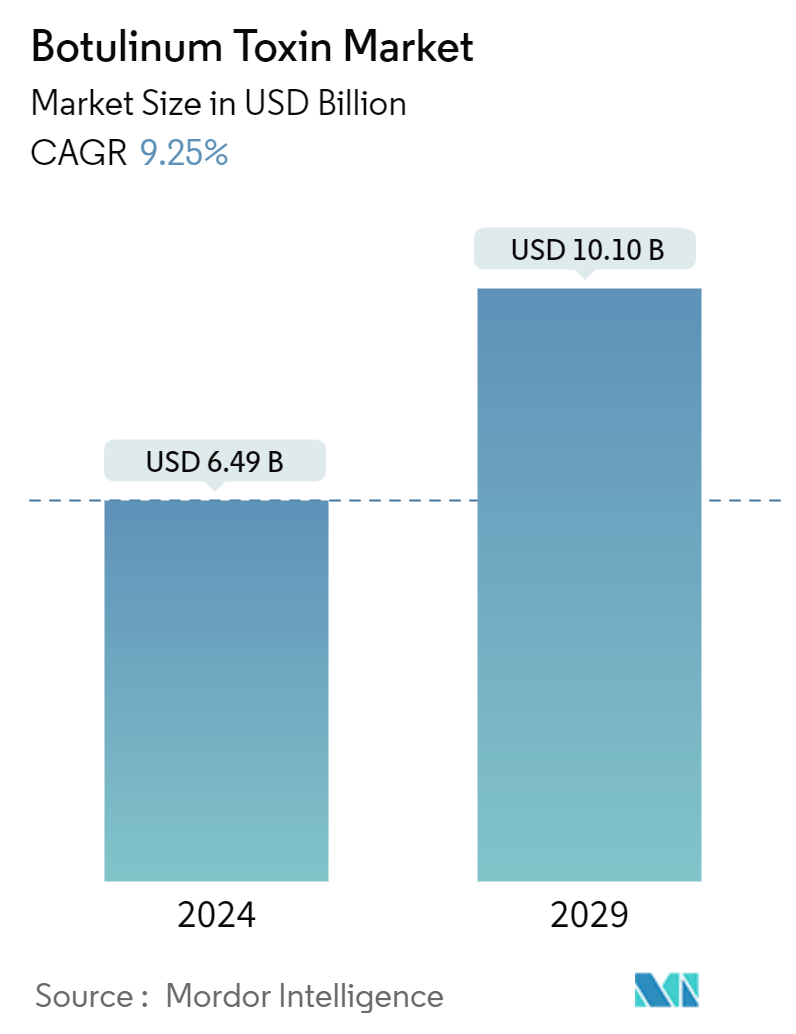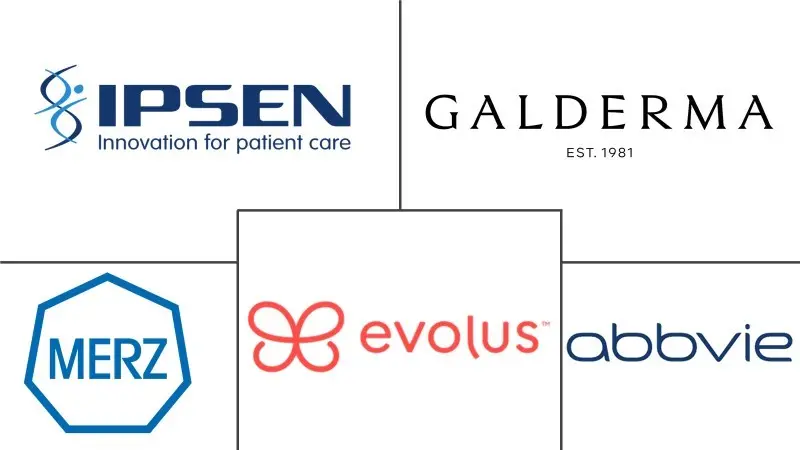Market Size of Botulinum Toxin Industry

| Study Period | 2019 - 2029 |
| Market Size (2024) | USD 6.49 Billion |
| Market Size (2029) | USD 10.10 Billion |
| CAGR (2024 - 2029) | 9.25 % |
| Fastest Growing Market | Asia Pacific |
| Largest Market | North America |
Major Players
*Disclaimer: Major Players sorted in no particular order |
Need a report that reflects how COVID-19 has impacted this market and its growth?
Botulinum Toxin Market Analysis
The Botulinum Toxin Market size is estimated at USD 6.49 billion in 2024, and is expected to reach USD 10.10 billion by 2029, growing at a CAGR of 9.25% during the forecast period (2024-2029).
Botulinum toxin has a range of applications in cosmetics and therapeutic spaces. Factors such as increasing demand for injectable aesthetic procedures, growing research and development initiatives to expand the therapeutic applications of botulinum toxin, and growing patient preference for non-invasive or minimally invasive cosmetic treatments are projected to facilitate market growth over the forecast period.
The increasing advantages of non-surgical aesthetic treatments and their growing procedural volumes are expected to spur market uptake over the coming years. For instance, according to an article published by the Journal of Cosmetic Dermatology in February 2023, botulinum toxin injectable procedures are considered trustworthy among people for increasing the attractiveness of the face and maintaining the naturalness of the face after the procedure, too. Thus, such advantages associated with botulinum toxin-based aesthetic procedures are likely to support market growth.
In addition, the growing procedural volumes of botulinum toxin-based procedures worldwide are another factor anticipated to foster market expansion over the study period. For instance, as per the 2022 report International Society of Aesthetic Plastic Surgery (ISAPS) published in September 2023, botulinum toxin-based procedures were among the most performed ones across the non-surgical aesthetic procedures category. For instance, in 2022, around 18,857,311 non-surgical aesthetic procedures were performed globally, and among them, 9,221,419 were botulinum toxin-based procedures followed by hyaluronic acid-based procedures. Thus, the increase in procedural volumes of botulinum toxin-based procedures is projected to accelerate market uptake over the forecast period.
Also, growing applications for the therapeutic usage of botulinum toxin in various non-cosmetic applications such as dystonia and migraine are expected to contribute to the growth of the market over the forecast period. Moreover, the prevalence of various disorders, such as movement disorders and musculoskeletal diseases, in which botulinum toxin can be used as the potential therapy is expected to drive the demand for botulinum toxin, thereby contributing to the market's growth.
For instance, according to an article published by HHS Public Access in March 2023, dystonia was one of the most common movement disorders with twisting postures, with an overall prevalence of 16.4 per 100,000 individuals, and was more common across all demographics. Thus, the higher burden of dystonia is expected to spur demand for botulinum toxin over the coming years as it has a proven role in reducing muscle stiffness and spasticity.
Also, the increasing clinical trial volumes for botulinum toxin and positive topline results of investigational candidates are further expected to contribute to the market's growth. For instance, in March 2024, AEON Biopharma Inc. announced positive clinical updates on its investigational candidate ABP-450 (prabotulinumtoxinA) for the management of migraine. Such positive topline results of the investigational candidates are expected to contribute to the market's growth over the forecast period.
Furthermore, innovative product launches to meet the growing demand for botulinum toxin are expected to boost the market's growth. For instance, in December 2022, Gufic Biosciences launched Zarbot, a botulinum toxin type A injection in India. This injection was manufactured in collaboration with the US-based Prime Bio and is useful in the management of certain neurological conditions.
Thus, the increasing demand for botulinum toxin in cosmetic and non-cosmetic applications and frequent product launches are expected to drive the market's growth over the forecast period. However, adverse effects associated with botulinum toxin and the lack of reimbursement policies supporting cosmetic procedures are expected to restrain the market's growth over the forecast period.
Botulinum Toxin Industry Segmentation
According to the report's scope, botulinum toxin is a neurotoxic protein produced by the bacterium Clostridium botulinum. As a result, highly diluted concentrations of botulinum toxin are used for cosmetic and non-cosmetic purposes, such as for the treatment of frown lines between the eyebrows, dystonia, chronic migraine, and other purposes. The botulinum toxin market is segmented by application, end user, and geography. By application, the market is segmented into cosmetic applications and non-cosmetic applications. By end user, the market is segmented into spas and beauty centers and clinics and hospitals. The report also covers the market sizes and forecasts for the botulinum toxin market in major countries across different regions. For each segment, the market size is provided in terms of value (USD).
| By Application | ||||||
| ||||||
|
| By End User | |
| Spas and Beauty Centers | |
| Clinics and Hospitals |
| Geography | ||||||||
| ||||||||
| ||||||||
| ||||||||
| ||||||||
|
Botulinum Toxin Market Size Summary
The botulinum toxin market is poised for significant growth, driven by its expanding applications in both cosmetic and therapeutic fields. The increasing demand for injectable aesthetic procedures, coupled with a growing preference for non-invasive treatments, is a key factor propelling market expansion. The market is also benefiting from ongoing research and development efforts aimed at broadening the therapeutic uses of botulinum toxin, such as in the treatment of dystonia and migraines. The rising procedural volumes of botulinum toxin-based treatments globally further underscore the market's robust growth trajectory. Innovative product launches and positive clinical trial results are expected to bolster market dynamics, although challenges such as adverse effects and reimbursement issues for cosmetic procedures may pose constraints.
Regionally, North America is anticipated to experience substantial growth, fueled by a high demand for aesthetic procedures and a significant prevalence of muscle disorders. The region's market growth is further supported by the presence of major industry players and a steady stream of product approvals for both cosmetic and therapeutic applications. The competitive landscape of the botulinum toxin market is moderately fragmented, with key players like Galderma, Evolus Inc., and AbbVie Inc. (Allergan) holding notable market shares. The market's growth is characterized by a combination of increasing procedural volumes, innovative product developments, and strategic collaborations among industry participants.
Botulinum Toxin Market Size - Table of Contents
-
1. MARKET DYNAMICS
-
1.1 Market Overview
-
1.2 Market Drivers
-
1.2.1 Increasing Demand for Aesthetic Procedures
-
1.2.2 Growing Research and Development Initiatives to Expand the Therapeutic Applications of Botulinum Toxin
-
-
1.3 Market Restraints
-
1.3.1 Adverse Effects Associated with Botulinum Toxin
-
1.3.2 Lack of Reimbursement Policies Supporting Cosmetic Procedures
-
-
1.4 Porter's Five Force Analysis
-
1.4.1 Threat of New Entrants
-
1.4.2 Bargaining Power of Buyers/Consumers
-
1.4.3 Bargaining Power of Suppliers
-
1.4.4 Threat of Substitute Products
-
1.4.5 Intensity of Competitive Rivalry
-
-
-
2. MARKET SEGMENTATION (Market Size by Value - USD)
-
2.1 By Application
-
2.1.1 Cosmetic Applications
-
2.1.1.1 Glabellar Lines
-
2.1.1.2 Lateral Canthal Lines (Crow's Feet)
-
2.1.1.3 Forehead Lines
-
2.1.1.4 Other Cosmetic Applications
-
-
2.1.2 Non-cosmetic Applications
-
2.1.2.1 Dystonia
-
2.1.2.2 Chronic Migraine
-
2.1.2.3 Ophthalmologic Disorders
-
2.1.2.4 Other Non-cosmetic Applications
-
-
-
2.2 By End User
-
2.2.1 Spas and Beauty Centers
-
2.2.2 Clinics and Hospitals
-
-
2.3 Geography
-
2.3.1 North America
-
2.3.1.1 United States
-
2.3.1.2 Canada
-
2.3.1.3 Mexico
-
-
2.3.2 Europe
-
2.3.2.1 Germany
-
2.3.2.2 United Kingdom
-
2.3.2.3 France
-
2.3.2.4 Italy
-
2.3.2.5 Spain
-
2.3.2.6 Rest of Europe
-
-
2.3.3 Asia-Pacific
-
2.3.3.1 China
-
2.3.3.2 Japan
-
2.3.3.3 India
-
2.3.3.4 Australia
-
2.3.3.5 South Korea
-
2.3.3.6 Rest of Asia-Pacific
-
-
2.3.4 Middle East and Africa
-
2.3.4.1 GCC
-
2.3.4.2 South Africa
-
2.3.4.3 Rest of Middle East and Africa
-
-
2.3.5 South America
-
2.3.5.1 Brazil
-
2.3.5.2 Argentina
-
2.3.5.3 Rest of South America
-
-
-
Botulinum Toxin Market Size FAQs
How big is the Botulinum Toxin Market?
The Botulinum Toxin Market size is expected to reach USD 6.49 billion in 2024 and grow at a CAGR of 9.25% to reach USD 10.10 billion by 2029.
What is the current Botulinum Toxin Market size?
In 2024, the Botulinum Toxin Market size is expected to reach USD 6.49 billion.

